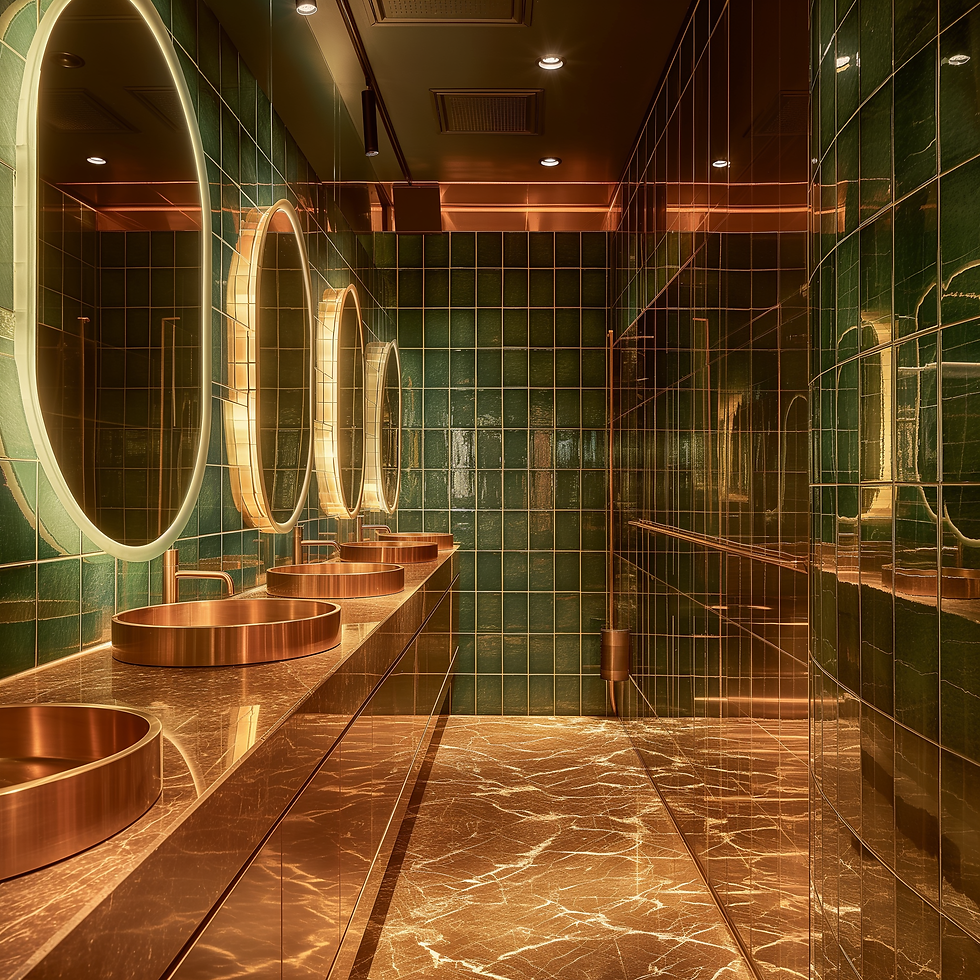Beyond the Dining Room: How Designers Are Transforming Restaurant Bathrooms into Conceptual Masterpieces
- Drake+Khan Design

- Jun 12, 2024
- 4 min read
Updated: Jun 17, 2024
© Restaurant Bathroom Concept Design / Drake + Khan Design
In the competitive world of restaurants and hospitality, every detail matters. From the moment guests walk through the door, their experience is shaped by the environment around them. While much attention is often given to dining areas, lobbies, and guest rooms, one crucial space is sometimes overlooked: the bathroom. Ensuring that design concepts extend seamlessly into the bathroom is not only a matter of aesthetics but also plays a significant role in shaping the overall guest experience.
Creating a Cohesive Experience
Consistency is Key
© Studio K / BLVD Steakhouse, Chicago
A well-designed restaurant or hotel thrives on consistency. When guests move from one area to another, they should feel a sense of continuity. This continuity reassures them of the establishment’s attention to detail and commitment to quality. A bathroom that echoes the design themes of the main areas — whether it's rustic chic, modern minimalism, or luxurious opulence — reinforces the brand identity and enhances the overall storytelling experience.
Enhancing the Guest Experience
Bathrooms are more than just functional spaces; they are a part of the guest’s journey. A beautifully designed bathroom can leave a lasting impression, contributing to the sense of luxury and care. A bathroom that continues the design narrative can elevate the entire experience, making guests feel pampered and valued.
The Role of an Interior Designer
Expertise in Concept Development
© Restaurant Bathroom Concept Design / Drake + Khan Design
Involving an interior designer from the outset of the concept development phase ensures that all spaces, including bathrooms, are considered in the overarching design plan. Designers bring a wealth of expertise in creating cohesive environments that are both functional and visually appealing. They understand how to balance aesthetic elements with practical considerations, ensuring that the design is not only beautiful but also durable and easy to maintain.
Attention to Detail
Interior designers are trained to pay attention to the finer details that might be overlooked by others. This includes selecting the right fixtures, lighting, color schemes, and materials that align with the overall design concept. For bathrooms, this could mean choosing high-quality, stylish fixtures, incorporating ambient lighting, and selecting durable yet attractive materials that can withstand high traffic.
Enhancing Brand Identity
A thoughtfully designed bathroom can also serve as an extension of the brand. For example, a boutique hotel with a unique theme can carry this theme into the bathroom, using custom tiles, artwork, and amenities that reflect the hotel's personality. This not only enhances the guest experience but also reinforces the brand’s identity and story.
Practical Benefits
Improved Functionality
Beyond aesthetics, a well-designed bathroom is functional and user-friendly. Designers consider factors such as layout, accessibility, and flow, ensuring that the space is easy to navigate and use.
Increased Value and Appeal
A cohesive design that extends to all areas of the establishment can increase its overall value and appeal. Potential guests and diners often judge the quality of a restaurant or hotel based on small details.
Better Reviews and Reputation
In the age of online reviews, every aspect of the guest experience is scrutinized. Bathrooms that match the quality and design of the rest of the establishment can lead to better reviews and a stronger reputation.
Real World Examples
Bacchanalia, London
© Johnny Stephens Photography / Bacchanalia, London / Martin Brudnizki Design
Martin Brudnizki Design Studio masterfully extended the luxurious and eclectic concept of London's Bacchanalia restaurant into its bathrooms, creating a seamless and captivating experience. The bathrooms feature intricate marble floors, opulent gold fixtures, and bespoke mosaic wall art that mirrors the classical art and mythology themes present in the main dining area. These design elements, combined with ambient lighting and sumptuous materials, ensure that the bathrooms are not just functional spaces but integral parts of the overall aesthetic narrative, providing guests with a continuous sense of indulgence and sophistication.
Bacchanalia, London
© The World of Interiors / Tutto Bene / Nightingale, London
Tutto Bene Design Studio elegantly extended the sophisticated and contemporary concept of London's Nightingale restaurant into its bathrooms, creating a captivating and cohesive environment. The bathrooms feature sleek black and gold accents, reflective of the restaurant's chic, modern design. Intricate geometric tile patterns adorn the walls, while ambient lighting casts a warm glow, enhancing the luxurious atmosphere. Custom vanity mirrors and high-end fixtures complete the design, ensuring that the bathrooms are an integral extension of Nightingale's overall aesthetic, offering guests a continuous and immersive experience of style and elegance.
Conclusion
In the realm of restaurants and hospitality, no detail is too small when it comes to design. Bathrooms, often overlooked, play a crucial role in shaping the guest experience. By carrying design concepts through to the bathroom, establishments can create a cohesive, memorable environment that delights guests and enhances the overall brand identity. Involving an interior designer in the concept development and design process ensures that every space is thoughtfully considered, resulting in a harmonious and high-quality experience for all. After all, in hospitality, it’s the little things that make a big difference.










Komentar